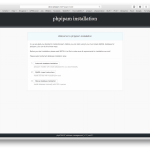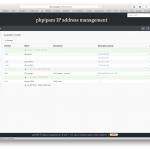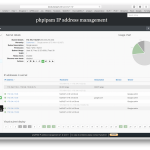4 Inevitable Questions When Joining a Monitoring Group, Pt.3
Leon Adato, Technical Product Marketing Manager with SolarWinds is our guest blogger today, with a sponsored post — the third in a four-part series on the topic of alerting. In the last two posts in this series, I described two of the four (ok, really five) questions that monitoring professionals are frequently asked: Why did […]
Author information
The post 4 Inevitable Questions When Joining a Monitoring Group, Pt.3 appeared first on Packet Pushers Podcast and was written by Sponsored Blog Posts.
Packet Flow with FirePower.
As I was going through some CiscoLive365 sessions (Remember CiscoLive365 is great!) just this last weekend I came across the slides for BRKSEC-2028 – Deploying Next Generation Firewall with ASA & Firepower services. Unfortunately there is no video for this session yet but the presentation slides are there and luckily the slides are detailed enough so […]DHCP Snooping – Filter those broadcasts!
I had a specific requirement recently and I wanted to test it’s behaviour. In particular the feature is DHCP snooping. Let’s quickly go over the DHCP process at a high level to see how it works: DHCP Let’s take the following simple diagram to show what’s going on. We have a switch with two hosts […]The Network as a Complex Distributed System
Through http://blog.ipspace.net I landed on this article on acm.org discussing the complexity of distributed systems. Through some good examples, George Neville-Neil makes it clear that creating and scaling distributed systems is very complex and “any one that tells you it is easy is either drunk or lying, and possibly both”.
Networks are of course inherently distributed systems. Most everyone that has managed a good sized network before knows that like the example in the article, minor changes in traffic or connectivity can have huge implications on the overall performance of a network. In my time supporting some very large networks I have seen huge chain reactions of events based on what appear to be some minor issues.
Very few networks are extensively modeled before they are implemented. Manufacturers of machines, cars and many other things go through extensive modeling to understand the behaviors of what they created and their design choices. Using modeling they will look at all possible inputs and outputs, conditions, failure scenarios and anything else we can think of to see how their product behaves.
There are few if any true modeling tools for networks. We build networks with extensive distributed protocols to control connectivity Continue reading
Performance Tests and Out-of-Box Performance
Simonp made a perfectly valid point in a comment to my latest OVS blog post:
Obviously the page you're referring to is a quick-and-dirty benchmark. If you wanted the optimal numbers, you would have to tune quite a few parameters just like for hardware benchmarks (sysctl kernel parameters, Jumbo frames, ...).
While he’s absolutely right, this is not the performance data a typical user should be looking for.
Read more ...InfluxDB and Grafana
Cluster performance metrics describes how to use sFlow-RT to calculate metrics and post them to Graphite. This article will describe how to use sFlow with the InfluxDB time series database and Grafana dashboard builder.The diagram shows the measurement pipeline. Standard sFlow measurements from hosts, hypervisors, virtual machines, containers, load balancers, web servers and network switches stream to the sFlow-RT real-time analytics engine. Over 40 vendors implement the sFlow standard and compatible products are listed on sFlow.org. The open source Host sFlow agent exports standard sFlow metrics from hosts. For additional background, the Velocity conference talk provides an introduction to sFlow and case study from a large social networking site.
It is possible to simply convert the raw sFlow metrics into InfluxDB metrics. The sflow2graphite.pl script provides an example that can be modified to support InfluxDB's native format, or used unmodified with the InfluxDB Graphite input plugin. However, there are scaleability advantages to placing the sFlow-RT analytics engine in front of the time series database. For example, in large scale cloud environments the metrics for each member of a dynamic pool isn't necessarily worth trending since virtual machines are frequently added and removed. Instead, sFlow-RT tracks all the Continue reading
RPKI: BGP Security Hammpered by a Legal Agreement
Resource Public Key Infrastructure (RPKI) is a relatively new standard for establishing BGP route origination. I wrote a brief introductory article here. Apologies for the self-promotion, but rather than rehash the basics here, I raise another issue that needs community attention: ARIN’s Relying Party Agreement (RPA: PDF link). Having said that, some basics are needed. […]
Author information
Will I Be Blogging Again?
Dan wrote in with a question: Hey, I like your site as well… are you going to be doing any more posts? It just seems odd that your last blog post was the analyzation of the site and how it portends to your future work. anyway, good luck I know it's tacky to write a blog post about how you're not writing enough blog posts… but here goes.Pioneers vs. Protectors in Cloud Networking Innovation
The innovation of hundreds of startup companies created the Internet, and the Internet has changed the world. Innovation continues to have a dramatic impact on networking in recent years. These new developments have changed the way applications, workloads and networks interact. Having been involved in this industry for more than three decades, I have witnessed and been part of these transformations from the 1980s to the 2015 era. Each phase of innovation has been characterized by new companies and entrants, as depicted below:
| PHASES OF NETWORK INNOVATION | Epoch | Vendors | Network Technologies | Trends |
|---|---|---|---|
| First 1980–1995 |
AT&T, Sun, 3Com, NET, Proteon, UB, BBN, DEC, IBM |
ARPANET, Circuits, Hubs, SNA, Ethernet, Token Ring, Routers |
Terminal-Mainframes and Minis, Channel Attach |
| Second 1995–2010 |
Cisco, Juniper, Nortel/Bay, Alcatel, Lucent, Avaya |
Switching, Multiprotocol Routing, LAN-WAN, TCP/IP |
PC, Client-Server, Web, North-South traffic |
| Third 2010–present |
Arista, VMware, Facebook, Microsoft, Splunk, Red Hat, Palo Alto, Aruba, many others |
The SDN Era of Open, Programmable Networking, DevOps meets NetOps, Universal Cloud Networks |
Mobile Virtual Workloads and Workflows, Big Data, Hyperscale Web, Virtual Machines / Containers |
Traits of a Pioneering Innovator vs. Protector
Dominant companies often fall by the wayside when they do not anticipate and react to clear market trends as Continue reading
BGP hijack incident by Syrian Telecommunications Establishment
The Syrian national Telecommunications Establishment (STE) has been in the news numerous times over the last few years, mostly because of the long lasting large scale Internet outages in Syria. This morning however we observed a new incident involving the two Autonomous systems for STE (AS29386 and AS29256). Starting at 08:33 UTC we detected that hundreds of new prefixes were being announced by primarily AS 29386. The new BGP announcements by STE (AS29386) were for prefixes that are not owned or operates by the Syrian Telco and as a result triggered ‘hijack / origin AS’ alerts for numerous BGPmon users. The announcements lasted for a few minutes only and we saw paths changing back to the original origin AS at about 08:37 UTC.
RIPE stat has some great tools that visualize the event, this example shows what happened to the youtube prefix 208.117.232.0/24
Propagation
STE buys upstream connectivity to the rest of the Internet via three providers, AS3491 (PCCW Global), AS3320 (Deutsche Telekom AG) and AS6762 (Telecom Italia Sparkle). The ‘bad’ BGP updates from this morning were only seen via Telecom Italia. This is either because STE only announced it to Telecom Italia, or because the other two providers filtered Continue reading
Vendor Whitebox Switches – Better Together?

Whitebox switching has moved past the realm of original device manufacturers and has been taken up by traditional networking vendors. Andre Kindness (@AndreKindness) of Forrester recently posted that he fields several calls from his customers every day asking about a particular vendor’s approach to whitebox switching. But what do these vendor offerings look like? And can we predict how a given vendor will address the whitebox market?
Chocolate In My Peanut Butter
Dell was one of the first traditional networking vendors to announce a whitebox switch offering that decoupled the operating system from the switching hardware. Dell offered packages from Cumulus Linux and Big Switch Networks alongside their PowerConnect lineup. This makes sense when you consider that the operating system on the switch has never been the strong suit of Dell. The PowerConnect OS is not very popular with network engineers, being very dissimilar from more popular CLIs such as Cisco IOS and its look-alikes. Their attempts to capitalize on the popularity of Force Ten OS (FTOS) and adapt it or use on PowerConnect switches has been difficult at best, due to the divide been hardware architecture of the two platforms.
What Dell is very good at is Continue reading
The Big YANG Theory
by Hariharan Ananthakrishnan, Distinguished Engineer - December 9, 2014
At this point in the evolution of the network, we think it is important to outline the history, pros, cons, and future of YANG. The data model in YANG helps in managing configuration for both traditional and software defined networks (even SDN needs some persistent state). Standardized YANG models will help in managing true multi-vendor networks.
What Is YANG Exactly?
As I outlined in “The Current State of SDN Protocols,” YANG is a data modeling language used to model configuration and state data manipulated by the Network Configuration Protocol (NETCONF), NETCONF remote procedure calls and NETCONF notifications. YANG was developed by the NETMOD working group in the IETF and was published as RFC 6020.
In the past few years, YANG gained a lot of traction with the open-source community. There are tools developed to validate YANG and transform YANG specification into other formats. Some tools can even generate JAVA code given a YANG specification. Router vendors noticed the traction and started contributing to model definitions, standardization and eventual support in their products.
My Experience
I got involved with YANG when Continue reading
Last Call: Overlay Virtual Networks in Software Defined Data Centers
If you want to get a free copy of my Overlay Virtual Networks in Software-Defined Data Centers book, download it now. The offer will expire by December 15th.
Just published: Enterprise IPv6 videos
The edited videos for my Enterprise IPv6 webinars have been published on my.ipspace.net. Enjoy!
Operations Manager to OMi Migration Path
HP has finally announced a migration path for Operations Manager to OMi. It’s about time too. This looks like a good path. If you want to stick with HP Software for managing your services, you should be investigating it.
The writing’s been on the wall for a while. HP has stopped investment in Operations Manager. I asked last year if HP had abandoned Operations Manager. This year I noted that it was kicking, but only just. My advice was:
To customers using HP OM…start planning your migration away from it, if you haven’t already. To customers considering purchasing it: Don’t, unless you’re buying it as part of an overall BSM/OMi implementation, and the salesfolk have guaranteed you can change your licensing over at no cost in future.
Well, HP has finally announced the OM2OMi Evolution program. Key points:
- License entitlement – OM servers can get equivalent licenses for OpsBridge Premium
- Operations Agent 11 works with both OM and OMi, so you don’t have to do the Agent migration at the same time
- Migration tools to assist with switching over
They do include this quote:
Well no one at HP is going to try to force you into replacing a product you love. Rest Continue reading
Johannesburg: CloudFlare’s 30th data center

Fire up the celebration braai, Jozi! CloudFlare is here, and it’s a big one. An important milestone (our 30th data center) calls for an equally important new location: Johannesburg, South Africa, our first data center in Africa.
For the local audience: Steek aan 'n braai ter viering, Jozi! CloudFlare is hier en dis 'n groot een. 'n Belangrike mylpaal (ons 30ste datasentrum), vra vir ewe belangrike en nuwe ligging: Johannesburg, Suid-Afrika, ons eerste datasentrum in Afrika.
Now serving Southern Africa
Prior to now nearly all CloudFlare traffic delivered to Africa was served from our London, Amsterdam and Hong Kong data centers with round trip latency of 200-350ms. Bandwidth in the region is notoriously expensive (it would make even the Australians blush) making it prohibitive to enter into the continent. That is, before now. Just a few months ago we were fortunate to enter into discussions with a number of partners in the region that share CloudFlare’s vision to help build a better Internet.

Our Johannesburg data center will not only make sites on CloudFlare more performant for Internet users in South Africa, but also for Internet users across all of Southern Africa (and beyond). From Botswana to Kenya, users Continue reading
Wireshark tid-bit: Quickly gathering the contents of a PCAP.
I don’t know about you but when I find myself performing packet captures and analyzing PCAPs I usually only know the symptoms of the issue I am attempting to troubleshoot. IE: Connection timeouts, slow response, long transfer times, etc. I usually don’t know much more than that, only in rare occasions do I get a […]phpipam v1.1 released :: security fixes, performance improvements, mod_rewrite optional
Dear all, I am happy to announce new version of phpipam IP address management – version 1.1.
This release fixed some bugs, provided some new features, but most importantly it was focused on:
- Security fixes (SQL injection, XSS scripting, crypting DB passwords, brute-force attack prevention, …)
- Performace improvements (Caching, reusing SQL connection),..
- mod_rewrite no longer required, selectable URL structure under settings
Some screens:



If you find phpIPAM useful for your company donations would be highly appreciated ![]()
You can demo it here: http://demo.phpipam.net/
You can download it on sourceforge site: phpipam-1.1.
Special thanks to all the people submitting bug reports, translators and feature testers!
Full changelog for this release is:
Enhancements: ---------------------------- + Caching of SQL results to avoid multiple queries; + Reduced number of DB queries; + Added selected mail notifications to admins to be notified on IP/subnet change; + Added new subnetId index to ipaddresses table that significantly improves network loading; + Now using only 1 network connection towards MySQL server; + Updated pagination; + mod_rewrite no longer required, selectable URL structure under settings; + Added option not to display free ranges; + Added option to set maximum VLAN number; + Selectable custom fields to Continue reading
Load Balancing in Google Network
Todd Hoff (of the HighScalability fame) sent me a link to an interesting video describing load-balancing mechanisms used at Google and how they evolved over time.
If the rest of the blog post feels like Latin, you SHOULD watch the Load Balancing and Scale-Out Application Architecture webinar.
The beginning of the story resembles traditional enterprise solutions:
Read more ...
